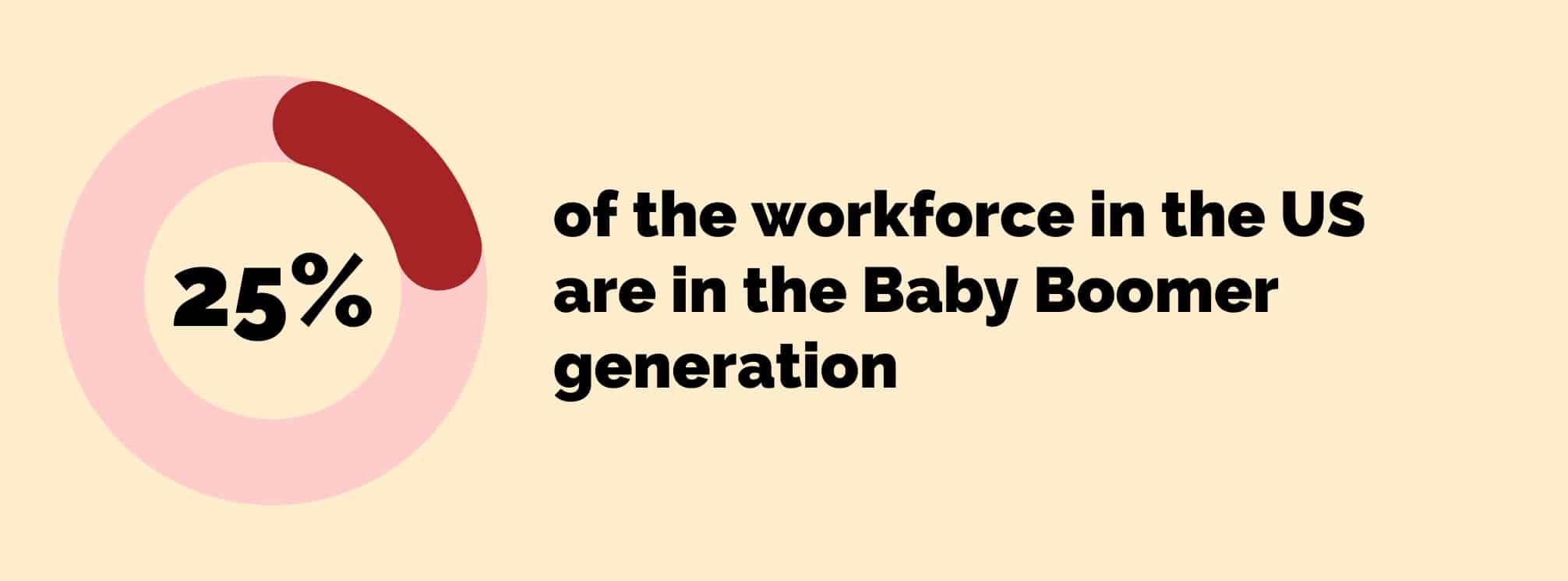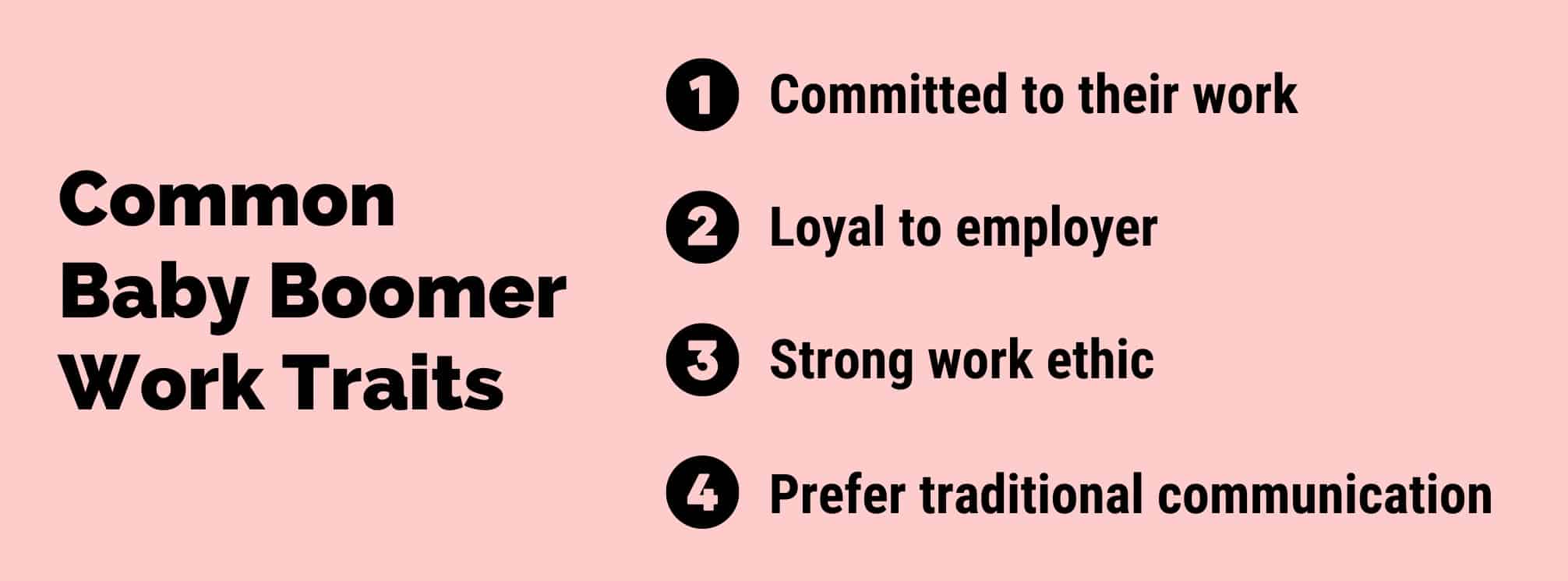
Right now, there is a considerable focus on how Millennials and Generation Z impact the workplace. But Baby Boomers were the original generation that changed the job and consumer landscape. And today, Boomers still make up a large part of the U.S. workforce and are working well past traditional retirement years. However, according to a Gallup State of the American Workplace Report, Baby Boomers are also the most disengaged segment of the workforce. This lack of employee engagement costs corporate America almost $500 million annually. So, how can we increase employee engagement of Baby Boomers in the workplace?
Baby Boomers are your employees who are 50 – 70 years old. They were born between 1946 and 1964, after the end of World War II.
Because of the political and social moment when they were born, a time of great economic growth, hope, and prosperity, many Boomers pursued higher education and professional careers. This has contributed to Baby Boomers being described as hardworking and very career focused. However, this generation still largely followed traditional gender roles when it comes to work.
In countries like the United States, Canada, and the United Kingdom, Baby Boomers are beginning to retire in large numbers. As of 2020, Baby Boomers only account for 25% of the workforce in the US.
Although this number is only going to continue to decline, they are still an essential part of your workforce. Don’t leave them behind just because they are no longer the majority.

Baby Boomers are your most tenured, seasoned employees. As such, this generation of workers has a lot of knowledge and experience.
But they also might tend to cling to what’s worked in the past and be more resistant to change. But please don’t let damaging stereotypes form your opinion. At the end of the day, you need to get to know your employees specifically and cater to their unique needs.
That said, here are a few common characteristics of Baby Boomers in the workplace:

So, how do you break through with this generation who are both hard-working, but also might have one foot out the door?
These five strategies can help you engage Baby Boomers in the workplace.
We all want to feel like we add value. And that our experience and contributions mean something to our colleagues and leadership.
And since Baby Boomers have a wealth of experience and knowledge, a great way to keep them engaged is to ask them to be mentors.
By setting up a mentorship program, they can pass along advice to those who are just starting or less advanced in their careers. In addition, it will remind them of what they love about their job and enable them to support a colleague’s growth. This has the added benefit of also providing learning and development opportunities to more junior workers, which boosts their engagement too.
This will give your Baby Boomers a chance to add tremendous value all while showing them you respect them and aren’t leaving them behind.
Baby boomers are often eager to learn and grow professionally. Don’t let looming retirement prevent you from investing in development and training opportunities! These employees are lifelong learners and will feel valued if you invest in their continued education.
A great way to do this is through microlearning content. This can teach employees more soft skills or industry best practices. And the investment doesn’t have to be incredibly high to get a strong ROI.
Rewarding Baby Boomers is key to keeping them engaged with their work. All employees want to be valued and appreciated regardless of their generation. Baby Boomers are no exception.
If you’re looking to start an employee recognition program or revamp an existing one, check out our free guide to frontline worker recognition. Ensuring that you have a great recognition program in place can tremendously increase the employee engagement of Baby Boomers in your organization.
We all have different communication preferences. And that goes far beyond the technology companies use for employee communication.
For instance, Baby Boomers tend to prefer:
Please remember that not all Baby Boomers are the same. It’s critical to do some internal research using employee surveys to learn what your specific employees prefer. This will go a long way towards you being able to target and personalize your communications in a meaningful way.
Baby Boomers, like all employees, have complex lives outside of work. So, employers need to communicate with their boomer workforce efficiently. Mobile technology presents an opportunity to directly push information to a device that most Boomers always have on them.
If you think this generation won’t want to use an employee app for company communication, think again. Pew Research has found that 97% of adults in the US have smartphones, and many are willing to use them for work.
Baby Boomers, like Millennials, are often subject to stereotypes that cause more harm than good.
So, when you consider how to best engage this generation in the workplace, we encourage you to ask them. This will help you tailor your strategy to your employees’ unique needs and wants.
Baby Boomers have changed the way we work. So, it’s critical to have the right programs to connect, motivate, and engage them.
Providing programs and technologies that take into account their busy lives and decades of experience will go a long way toward engaging Baby Boomers.
With theEMPLOYEEapp, we believe that it’s important to offer a variety of channels to your employees. There is no silver bullet that will work for all generations, just like there isn’t one solution for all Baby Boomers. Your workforce is diverse, your channels should be too.
If you want to learn more about how our communications solution can help you engage your Baby Boomers, please request a demo today.
[optin-monster slug=”gqorn0natkqgyrtjvr6i” followrules=”true”]